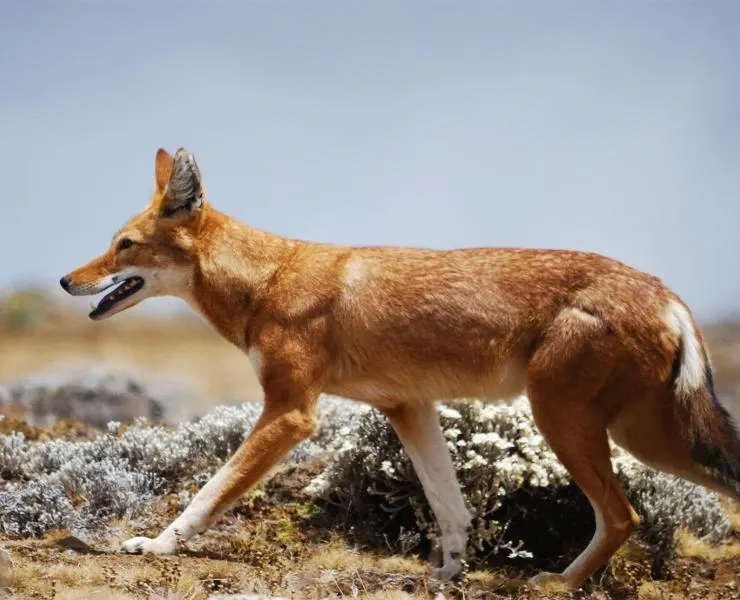Key Features of the Ethiopian Wolf
- Specialized habitat and role: The Ethiopian wolf is a specialized rodent hunter in Afroalpine ecosystems and unique African high-altitude regions.
- These ecosystems, located mainly in the Ethiopian Highlands, exist at altitudes of 3,200 meters above sea level and are characterized by cold and harsh climates.
- Physical characteristics: The wolf is about the size of a large dog, with a reddish coat, white throat and chest markings, and a bushy black tail.
- Population status: With fewer than 500 individuals remaining, the Ethiopian wolf is Africa’s most endangered carnivore.
- Habitat specificity: It resides in isolated “sky islands”, high-altitude regions above tropical forests, surrounded by drastically different lowland environments.
Ethiopian Wolf’s Role as a Pollinator
- Interaction with Ethiopian red hot poker flower: The wolf feeds on the nectar of the red and yellow Ethiopian red hot poker flower, a plant that produces sweet nectar attracting multiple pollinators.
- As the wolf moves between flowers, pollen dusts its muzzle, potentially aiding in pollination.
- Behavioural observations: Researchers observed wolves spending significant time in flower fields, with one wolf visiting 30 flower heads in 1.5 hours.
- This behaviour indicates that the wolf actively seeks nectar, a rare trait for large carnivores.
Q1: What is pollination?
Pollination is the transfer of pollen grains from the male part (anther) of a flower to the female part (stigma) of the same or another flower, enabling fertilization and the production of seeds. It is essential for plant reproduction, biodiversity, and the production of fruits, vegetables, and seeds that sustain ecosystems and agriculture.
Source: DTE
Last updated on June, 2025
→ UPSC Notification 2025 was released on 22nd January 2025.
→ UPSC Prelims Result 2025 is out now for the CSE held on 25 May 2025.
→ UPSC Prelims Question Paper 2025 and Unofficial Prelims Answer Key 2025 are available now.
→ UPSC Calendar 2026 is released on 15th May, 2025.
→ The UPSC Vacancy 2025 were released 1129, out of which 979 were for UPSC CSE and remaining 150 are for UPSC IFoS.
→ UPSC Mains 2025 will be conducted on 22nd August 2025.
→ UPSC Prelims 2026 will be conducted on 24th May, 2026 & UPSC Mains 2026 will be conducted on 21st August 2026.
→ The UPSC Selection Process is of 3 stages-Prelims, Mains and Interview.
→ UPSC Result 2024 is released with latest UPSC Marksheet 2024. Check Now!
→ UPSC Toppers List 2024 is released now. Shakti Dubey is UPSC AIR 1 2024 Topper.
→ Also check Best IAS Coaching in Delhi
Tags: ethiopian wolf Prelims Pointers upsc current affairs upsc prelims current affairs
























